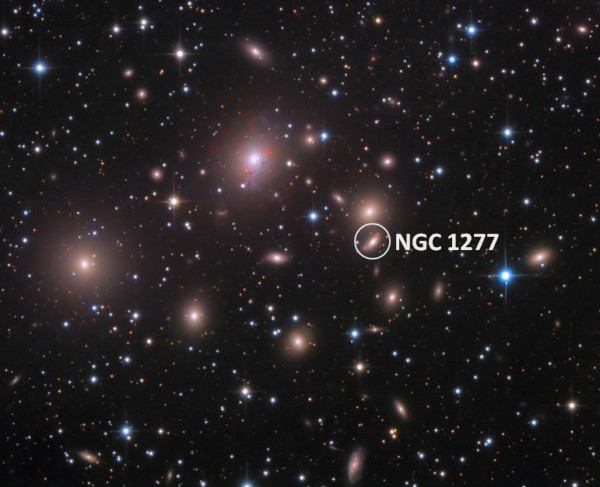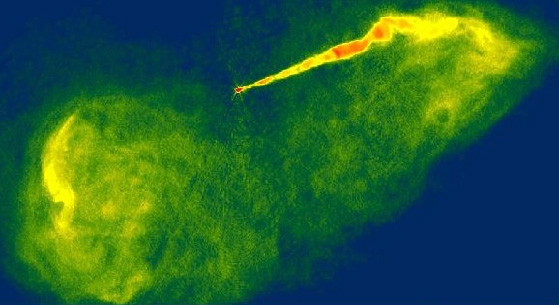“You cannot, in human experience, rush into the light. You have to go through the twilight into the broadening day before the noon comes and the full sun is upon the landscape.” -Woodrow Wilson
You might think of black holes as cosmic rarities, but the fact of the matter is that pretty much every time we form new stars in large numbers, we're going to wind up forming black holes as well. This is something that, over the nearly 14 billion year history of the Universe, each and every galaxy has had literally thousands (if not millions) of opportunities to do.
Now, these black holes are typically only a few times the mass of our Sun, but over time, they can grow, merge and devour other matter to reach millions or even billions of solar masses! So where are the largest ones in the known Universe?
 Image credit: NOAO / AOP, ©2005-2013 University of Texas McDonald Observatory, via http://blackholes.stardate.org/objects/image.php?id=82&img=225.
Image credit: NOAO / AOP, ©2005-2013 University of Texas McDonald Observatory, via http://blackholes.stardate.org/objects/image.php?id=82&img=225.
The answers are going to surprise you. Go read the whole thing and find out!


very nice!! black holes are much more tied to the formation of galaxies then we give them credit IMO. Fascinating objects.
p.s. and you really have to give it to GR! Not only did it predict BH when noone in their right mind imagined something like that existed, but at the same time it said "this is as far as I will go".. find a new guide for the next stage of the journey ;) Brilliant.
@Ethan: There seems to be a bit of controversy about NGC 1277; where do you stand on Eric Emsellem's model estimate that the SMBH mass is only 2~5 GMsun? That puts it at just a few percent of the galaxy mass.
The OJ-287 mass seems much more solid. Having a Keplerian system makes the problem more tractable, and less prone to model-dependent uncertainties.
I do love a SMBH.If there is a chink in GR then they must be the best way to find it.
Have you seen the paper by Laura Mersini-Houghton on the possible limit of their collapse.
http://arxiv.org/abs/1406.1525
Didn't there used to be speculation that black holes were essential for galaxy formation or is that hypothesis no longer in vogue? And what happens when the black holes in OJ 287 finally merge? Just a spectacular test of GR or something a little more colorful?
Very cool blog - answers a lot of questions very competently, with great evidence. Thank you!
@Scent
there are studies going on with that. i.e. http://arxiv.org/abs/1109.6265
but it's all observational. It's a bit "chicken and the egg" thing. Did SMBH just form as a side-effect of galaxy formation, or are SMBH needed for galaxy formation.
@ David Hurn
have started to read the paper you linked and stopped on the 3rd page at this:
"The crucial point to be emphasized here is: Hawking
radiation is produced by the changing gravitational field
of the collapsing star, i.e. prior to the black hole forma-
tion. Otherwise the surface gravity of the black hole "κ", and the temperature of Hawking radiation would increase with time, leading to a nonthermal distribution of radiation. The event horizon of the black hole traps consequent photons of radiation produced near the event horizon. The photons produced after γ f can not travel outwards, rather their geodesics focus inside the black hole. More explicitly, the surface gravity of the Black Hole is defined in terms of the 4-acceleration of an exter-nal observer. If "κ" were increasing with time, so would the acceleration of inertial relative to freely falling observers. For these reasons, quantum gravitational particle creation occurs during the collapse phase of the star."
Now this is something I heard for the first time and not sure this is correct, some professional opinion would be usefull here. But this has long lasting consequences. If Hawking radiation works as she thinks it works, then i.e. BH wouldn't be able even in theory to evaporate through hawking radiation, which is at the moment thought that they do.
I can certainly imagine a BH without a singularity, But her paper is based on one huge aspect, she cites sources, but sadly I do not have access to those. I thought hawking radiation is created at the event horizon, after BH formation. And I thought that even Hawking worked in this framework. She sais Hawking radiation happens during the star's colapse, inside the core. Would like to hear Hawking's opinion on that.. he's alive after all and in Cambridge where she is.
Great subject! Supermassive black holes are indeed a tremendously important key to understanding our universe - in all the ways you mention, and then some...(as I'm confident you well understand, even cosmologically speaking: they are terrific to the literal limit of existence).
The information you bring to your articles is splendidly and satisfyingly copious, as far as I am aware, like no other site supplies: reliably accurate and superbly fortified by images.
However, if I may I hazard a friendly word of advice? PLEASE TRY not to go overboard with the excessively enthusiastic prose. Its not just that its distracting, its actually harder to READ. If I see another exclamation mark, I'm afraid I might gag up a dollop resembling Phil Plait. Please don't subject your readers to that - I guarantee they are already sufficiently jazzed about how cool the universe is and what we are finding out about it (trust me, if they come to visit here, they are already primed) so that they don't need the artificial excess of flavoring to pump them up.
Carry on
(maybe a bit less frantically)
It IS possible to convey your personal enthusiasm in terms that won't drive your readers away screaming for the exits.
Otherwise, mark me as a genuine admirer of your site.
I enjoyed this article very much including the great images. The scales and masses being described are truly mind-blowing. It will be a feat to remember them but here's a handy list for anyone:
* Milky Way Galaxy's Most Massive Black Hole (MMBH) = ~4 million suns
* Messier 87's MMBH in the Virgo Cluster = ~6.6 billion suns
* NGC 1277's MMBH in nearby Perseus Cluster = ~17 billion suns (14% of galaxy mass compared to more typical .1%)
* Ultradistant OJ287's MMBH = ~18 billion suns
* Largest galaxy IC 1101's MMBH in Abell 2020 Cluster = TBD!
Thank you!
Loved the information. Detail, depth, clarity - and stuff I didn't know. Didn't like all the italics and exclamation points. I can tell if something is impressive. Makes you read like a junior high school kid, and your work deserves better. Thanks for the article. I wish I could be around when those two black holes merge. (!)
There's a nice discussion of OJ-287 here from 2010:
http://backreaction.blogspot.com/2010/04/oj-287.html
It is really more incredible than the article makes it sound, which is impressive in of itself.
You are a smart man with words and photos representing your views of a massive black hole having intense gravity. Your views influence people with a learning of the Cosmology.
For this reason I ask you to quote, this is a probability and I may be completely wrong. Jacktar.
I very much Like space it very much interest me indeed!
Dear Ethan,
Sorry, but I think you are not well updated. How about if you check the official list of Wikipedia of the largest known black holes?:
https://en.wikipedia.org/wiki/List_of_most_massive_black_holes
Why so many "!"? Most did not make any sense within the context of where they were used. Their egregious overuse made the article annoying and hard to read.